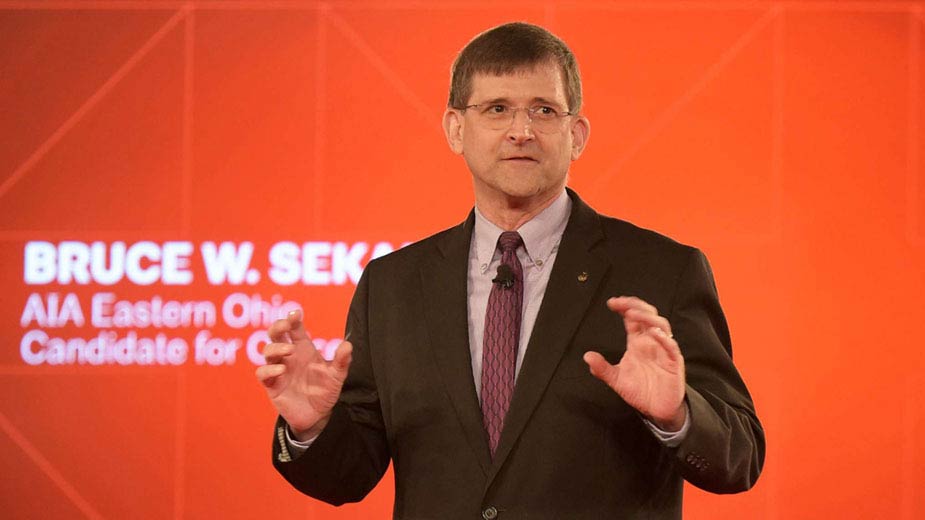Area Architects Provide Leadership for Profession
YOUNGSTOWN, Ohio — In sixth grade, Denise Holt recalls, she and her classmates had to give presentations on what they wanted to be when they grew up. While her classmates aspired to be doctors, lawyers or professional athletes, she wanted to be an architect.
“My teacher asked me if I knew what they did,” she says.
She did, of course – her father was a contractor and Denise had been running around wearing a hardhat since age three.
Today, Holt is a principal in The Workshop Arch+Design LLC and this year is president of the Eastern Ohio Chapter of the American Institute of Architects.
The chapter, one of eight in Ohio, covers Mahoning, Trumbull and Columbiana counties. It has 60 members, recently went through accreditation and is one of the smallest AIA chapters in the country, Holt says.
“Our chapter, under today’s standards, would not be allowed to be a chapter,” she continues.
One of AIA’s main activities is offering its members continuing education courses, she reports. Each month, the chapter offers at least one class related to health, safety or welfare issues that “could include anything from building envelopes to door hardware to [Americans with Disabilities Act] access of a building, waterproofing for foundations, ceilings,” she says.
AIA also has state and national political action committees, she notes.
In recent years, the Eastern Ohio Chapter has become involved in initiatives such as Streetscape and worked on programs with the Builders Association of Eastern Ohio and Western Pennsylvania. Holt is looking at doing a “can-struction” project, where architects design structures – not necessarily buildings – built of cans.
The Mahoning Valley is well represented at both the state and federal levels. Gregg Strollo, partner at Strollo Architects in Youngstown, is president of AIA’s Ohio Chapter and Bruce Sekanick, a principal in the Warren firm of Phillips/Sekanick Architects, this summer was elected secretary of AIA’s national board of directors.
Like Holt, Strollo’s path to the profession began when he was a youth spending time on construction sites with his father, also an architect. “It was a summer job that grew into a profession,” he says.
“I viewed it as noble work,” Strollo continues. “I idolized my father’s commitment to excellence. That was an easy role model and target for a life.”
The state chapter monitors legislation that affects architects, advocates for the profession, encourages the self-policing of ethical standards and promotes the value of the profession in the communities it serves.
The chapter is “pretty effective in steering, or at least advising,” lawmakers on legislation, Strollo says. One example is the so-called Good Samaritan law, which protects architects who volunteer their services during disasters from litigation.
“We need to get involved a lot of times on a volunteer basis,” Strollo says, but until recently architects were held liable for their role. “This allows us to step up in times of crisis without fear of litigation.”
The state organization advocated maintaining the state historic preservation tax credit program, Strollo continues. Absent those credits, projects such as the Wick Tower, Erie Terminal Place or Wells Building, which his firm renovated, would not have happened, he says.
Sekanick says he always wanted to become an architect. Part of his inspiration came from growing up outside Pittsburgh in a community that the architect Walter Gropius designed as a model community.
“I never knew the planned community was anything special,” he says, “but later as I went to school, I realized it was a special piece of architecture.”
Sekanick is the first member of the Eastern Ohio Chapter to serve on the national board, which he joined two years ago. “We’ve always done very well at the state level,” he says. “We’ve had a number of people here from local firms serve on state board and especially as president of the board.”
Sekanick takes office in December as board secretary.
“Right now I am learning everything I need to do during that process,” he says. “It’s quite involved but the existing secretary has been very generous with his time in training me. So far it’s been a very gratifying experience.”
At the national level, AIA’s role includes providing standard contract documents, organizing continuing education programs, performing “a certain degree of marketing,” presenting awards and conducting research, and working with other organizations, Sekanick says.
“We have knowledge communities,” he says. “So if you are interested in historic preservation, you can work with others worldwide on that issue. If you’re interested in building codes, the same applies.”
Pictured: Bruce Sekanick takes office in December as secretary of the national AIA board.
Copyright 2024 The Business Journal, Youngstown, Ohio.


